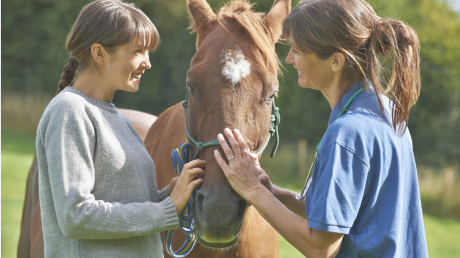
The Fear Free Veterinary Certification Program – Equine helps reduce injuries to veterinary staff and horses, improve the health and wellbeing of patients, and earn your clients’ lasting trust and commitment.

The Fear Free Veterinary Certification Program – Equine helps reduce injuries to veterinary staff and horses, improve the health and wellbeing of patients, and earn your clients’ lasting trust and commitment.
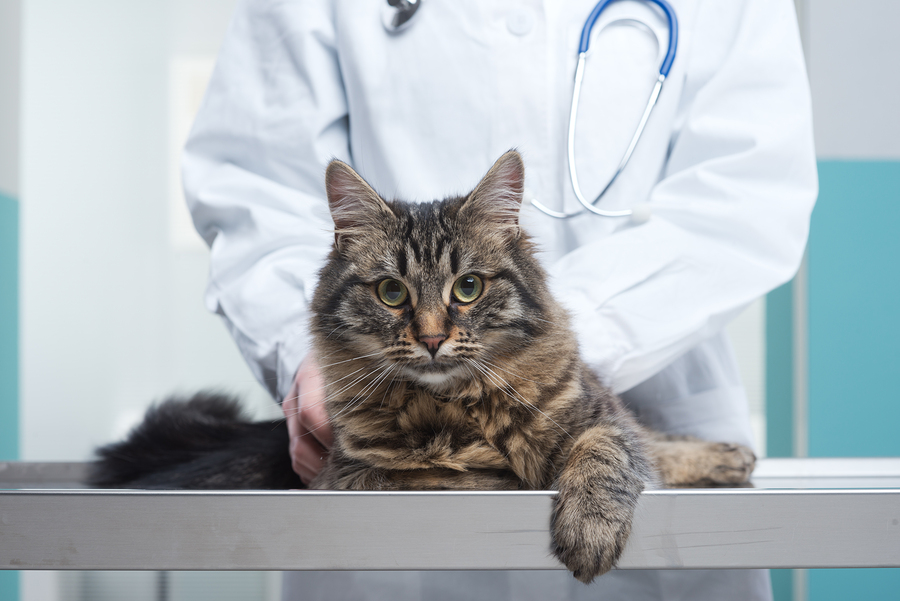
But there are also medical issues where a potential connection to a behavior problem may be less obvious. One that can be tricky to diagnose and that affects behavior in a wide range of ways is pain.
A recent article published in the journal Animals reviewed records of 100 dogs seen by the 13 coauthors and found that conservatively, a third of them involved some form of pain, and in some cases possibly up to 80 percent.
Coauthor and board-certified veterinary behaviorist Margaret E. Gruen, DVM, Ph.D., of North Carolina State University says, “We want to raise the consciousness that there are a lot of things where pain can be a contributor.” When clients come in with behavior issues, she says, “we want to be really specifically looking for discomfort, even if it’s behavior where we’re not immediately thinking, oh, that could be pain.”
It can be tricky, because pain in animals is not always obvious. “Unless you are really well versed in pain, it can be hard to pick up a painful animal in the exam room,” says Mike Petty, DVM, CVPM. “They put on a show about how well they feel. We will see dogs limp across the parking lot and then quit limping when they hit the front door.”
This means that knowing how to look for it is critical. “Primary care providers must keep an open mind that absolutely any change in their patients’ behavior that the client reports can be related in some way to pain. That means doing a good pain palpation as a part of every examination,” says Robin Downing, DVM, DACVSMR. “Only by including a pain palpation in every examination will a practitioner become proficient in identifying even subtle pain in patients.”
It’s also important to be aware of the many demonstrated connections. An increasing number of behavioral effects of pain and discomfort are being found in research. As more of these are studied, what’s “obvious” changes. “Compulsive licking in cats is a fantastic example,” says Dr. Gruen. While this was once commonly assumed to be a result of stress, after research revealed that approximately three-quarters of cats with compulsive licking actually had an underlying dermatological issue, such cats are now more likely to be treated correctly.
A less well-known example involves compulsive behaviors such as stargazing, fly-snapping, and pica. Research has shown that these can result from gastrointestinal problems in dogs.
And while inappropriate elimination as possible evidence of pain is well known in cats, it’s perhaps less frequently considered that pain can also be connected to housesoiling in dogs. “Oftentimes it’s too much effort for the dog to go and find their owner, or they dread going down the three steps into the backyard,” says Dr. Petty. “So they will sometimes go to the door and urinate or defecate there, or sometimes won’t even go to the door and just do it wherever they are.”
It’s often not easy to tell the difference between pain and cognitive decline, both of which can happen as pets age — and the two can interact as well.
“If a dog is acting weird, it might not be simple cognitive decline; it might be cognitive decline driven by pain,” says Petty. “Sometimes animals are in so much pain they can’t even think straight, so they’re much more likely to have behavioral issues.”
A sign such as apparent disorientation could be due to physical issues: a dog who seems to be stuck standing on a rug might be reluctant to cross a slippery floor because walking on it hurts. An apparent decrease in sociability could also be due to undiagnosed pain: “If you’re getting up and moving around the house, they’re less likely to follow you from room to room,” says Petty. “I always say to these clients, let’s make sure there isn’t a pain issue that pushing your dog over the edge, while we look at this cognitive issue.”
Petty thinks that teasing apart these potential causes is especially important because they often push people toward the decision to euthanize, since the dog doesn’t seem to be enjoying life and the pet-owner bond can be affected. Treating pain can help, as well as encouraging owners to modify their expectations for an aging pet. It may not be that the dog doesn’t enjoy his favorite activities anymore so much as they need to be modified: say, rolling the ball a short way instead of throwing it across the yard. He tells clients, “Think of what the dog used to like to do and tone it down.”
Because pain isn’t always obvious on examination, listening to the owner’s observations is crucial — but these may also need to be guided.
“When I speak with my clients about the possibility of pain in their pets, I alert them that any changes in behavior must lead us to at least consider pain as the culprit,” says Dr. Downing. “So, this means changes in eating and drinking, changes in getting onto furniture/beds, reluctance to ascend or descend stairs, decreased grooming (cats), restlessness at night (or the converse – – sleeping excessively), decreased interaction with human or animal family members, “grouchiness,” any changes in housetraining or litter pan use, objections to petting/brushing, decreased stamina on walks, or any other changes they may witness.”
But even for owners, these changes can also creep up so slowly that they almost don’t notice them. “It’s very common with chronic pain issues that once they’re treated, the owner says, ‘I just realized it’s been two years since he jumped on a couch,” Petty says. He strongly recommends using a questionnaire such as the Canine Brief Pain Inventory starting when pets are six or seven years old. “If you give this to every dog owner that walks in for their annual exam and have them answer these questions, you’ll be amazed at the red flags that come up.”
Lack of change where it can reasonably be expected can also be a hint, where behavior modification isn’t working. “If we have a patient who is working with someone, and they’re doing lots of appropriate things and not making progress, that’s when you want to think, let’s look even closer,” says Gruen. “Are we seeing anything that could be pain?”
Finally, it’s also important to remember that even when an underlying medical issue is identified, both medical and behavioral treatment may be needed.
“We need to know what the medical conditions are but that doesn’t necessarily mean treating that will solve the behavior problem,” says Gruen. “A good example is noise phobia.” In a dog who has some pain along with some fear of fireworks, for example, tensing up at the frightening noise may also cause physical discomfort. “That gets associated with the noise, so worsens the behavior problem.”
Similarly, when cats have urinary tract issues or pain that causes them to start avoiding the litter box, simply solving the medical problem may not be enough. “You can treat the infection, but the aversion is set up and persists,” she says.
Likewise, simply treating the behavior isn’t going to work if an underlying medical issue has been missed. “Making changes in those other pillars of the treatment plan is important and will be helpful, but it’s an uphill battle if you have an untreated medical concern,” says Gruen. “Particularly if it’s pain and discomfort, because that affect so many things.”
This article was reviewed/edited by board-certified veterinary behaviorist Dr. Kenneth Martin and/or veterinary technician specialist in behavior Debbie Martin, LVT.
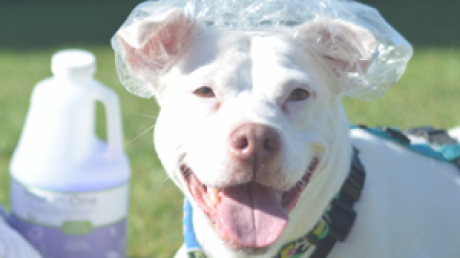
Bath time is scary for many animals—whether it’s the sound of the water, the feel of it on their skin, being restrained, or the tub itself. This one-hour module will teach you how to break down the bathing process into individual components that can be worked on separately to allow for calmer, safer bathing experiences. We will provide step-by-step desensitization and counterconditioning plans for every component—introducing the shampoo bottle, entering the tub, introducing water, and introducing the sound and feel of the dryer. You’ll also learn what you can do to modify the bathing environment to make it more inviting and less stressful for animals.
There are three lessons in this course:
Lesson 1: Overview of Fear Free Bathing and Positive Reinforcement
Lesson 2: Introduction to the Tub
Lesson 3: Modifying the Environment for Success
This one-hour course was designed for Fear Free groomers but is also open to our veterinary professional and trainer members. It was written by Terrie Hayward, M.Ed., KPA Faculty Member, CPDT-KA, CSAT, co-author of the book Grooming Without Stress, and is approved for one hour of RACE CE.

How to Get a Written Offer In Hand Before Interviewing
Finding a new job can be a high-stress and time-consuming process. If you stop to think about it, it’s not all that transparent either. When you ask about compensation, you’ll get vague answers like, “Our RANGE is this.” They may even initiate the conversation with the all-too-common trick question, “So what are you looking to make in your next role?”
After they succeed in making you comfortable with their non-answer, you’ll start the screening process. Phone calls upon phone calls followed by interviews upon interviews. This can take days, weeks, possibly months depending on your class schedule and availability. Then, at the very end, they make you the offer, which is the point which will determine if all the personal time you just gave them was worth it. If that offer is lower than you expected and you decline it, all that time is wasted and you’ll have to do it over again with another employer.
The last thing you want to waste during veterinary school is time. You have chosen to become a part of one of the most admirable professions in the world. You deserve a transparent process that values your time. Join Paul Diaz, founder of Hire Power Consulting, to learn how his company is working to help veterinarians level the job search playing field by empowering you to decide who you give your time to AFTER they provide you with a detailed offer first.
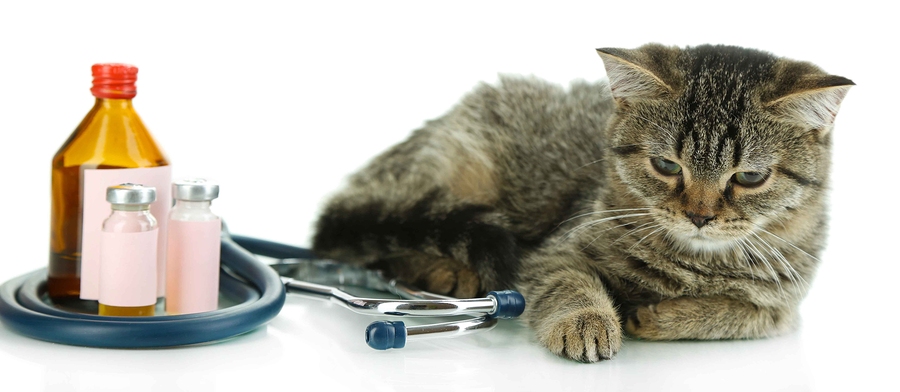
When a patient is fearful of seeing me at a veterinary hospital, their world shrinks to two options: flee or fight. Neither one is fun for them or helps me do what I’m supposed to do for the patient and the family who loves them: find out what’s wrong and make it better.
With patients who are driven by fear, their natural instincts kick in and they resist everything we need to do to get them well.
I’m sure you’ve all been there when trying to treat a fearful patient. Patients displaying aggression are driven by fear. The vast majority of them don’t display this type of behavior at home – so why do they revert to aggression when we are trying to help them?
Think of their first few visits to the hospital and try to see it from their perspective. The car ride. They are likely apprehensive when loaded into the car or carrier. Their owner may try to soothe them with calming words, but fear takes hold.
The sights and smells. When they arrive at the hospital, they can smell the fear from dozens – hundreds – of other pets before them. They can smell the odors of the hospital – cleaning and disinfecting products, the cautery unit in surgery, the parvo dog in isolation. Their heightened sense of smell, many thousands of times what ours is, wafts all of these to them: smells of sickness and death. They sense that this is a bad place.
After this – needles, restraint. The inability to move. The fear of being atop the exam table with no place to run.
Is it any surprise, then, that they would grow to dislike this place and its occupants?
We know that we want to help them. We know that a vaccine will prevent deadly diseases, that a spay will prevent unwanted pregnancies and pyometra…but they don’t.
Lest I be misunderstood – I am not saying that a veterinary hospital is a bad place – not at all. I love them and I know the good that veterinarians do each and every day to protect and preserve animal health and promote healing. We just need to find a way to explain it to our patients.
Since we can’t use words (or my favorite means of communication – interpretive dance), we have to show them by our actions. We have to note the aspects of our places of work and our way of handling them and convey the concept that this is not a bad experience. We have to make their perception of this is a bad place become Hey, this ain’t half bad.
I know it can’t happen each and every time – I can’t take the time to cozy up to the Great Dane that just came crashing into my ER with a GDV – but I can take the time to make sure his post-op stay is as free of pain and anxiety as I can safely make it.
Fear Free is a mindset. It’s a new way of looking at our interactions with patients to suss out aspects that can be improved, spikes of fear that can be dulled, practices and protocols that can be improved.
Why?
You can look at it as a moral imperative – we have taken an oath. It’s the right thing to do. No patient should be worse off for seeing us.
You can look at it practically, as well.
Imagine the stress of trying to do a toenail trim or a heartworm test on a 90-pound dog displaying fear and aggression. That dog is probably recalling all sorts of memories, stretching back to puppyhood, of nauseating car rides, stressful physical restraint, triggering smells.
Now imagine a dog who saw each visit before this one as a chance for treats, pets, and gentle interaction. Happy visits – just in and out the door, and he didn’t even notice the DHLPP jab because he was too busy licking peanut butter off of a kind hand and the veterinarian giving the shot used a brand-new needle. Imagine a dog who received safe sedation for a laceration instead of being held down and receiving nothing but Brutacaine.
Which dog do you think will let you trim his toenails with less stress – for all of you?
Fear Free isn’t just about the patients. How many times do you think your top-tier tech will wrestle with that dog before she hears the siren call of nursing school? How many times will you look at the chart of the FAS 5 dog and feel your heart sink? Feel burnout creeping ever closer?
This doesn’t happen with a calm pet who knows that a visit to a veterinary hospital is a good thing, not a terrifying experience. In my 20 years of emergency practice, I’ve seen fear quite literally kill many patients – patients who are barely coping with illness at home, who then take a lethal turn when the fright of a car ride or veterinary visit tips them over the edge. Fear Free could have saved many of them.
If you take a patient who’s comfortable with the whole process in a veterinary hospital – check-in, physical exam, diagnostic tests, and going back home – you have a patient who doesn’t want to flee or fight me or my team. They’re cooperative and calm – they might enjoy the whole thing if we give them love, confidence, and, of course, plenty of treats). And judicious use of sedatives and analgesics can help offset the fear, anxiety, and stress of visits and procedures. Fear Free patients will let me run the tests and do the physical exam that gets me the answers I need to deliver the best care I can.
Without fear – when pets are Fear Free – it’s not only easier for everyone, it’s better medicine. It’s less stress – for everyone. It’s fewer shots in the dark. Fewer guesses, fewer misdiagnoses, fewer “let’s-see-if-this-fixes-it” treatments ending in lost time, bad outcomes, and problems like global antibiotic resistance. Fear Free practices mean more pets go home faster, and you and your staff are happier and more productive.
This article was reviewed/edited by board-certified veterinary behaviorist Dr. Kenneth Martin and/or veterinary technician specialist in behavior Debbie Martin, LVT.
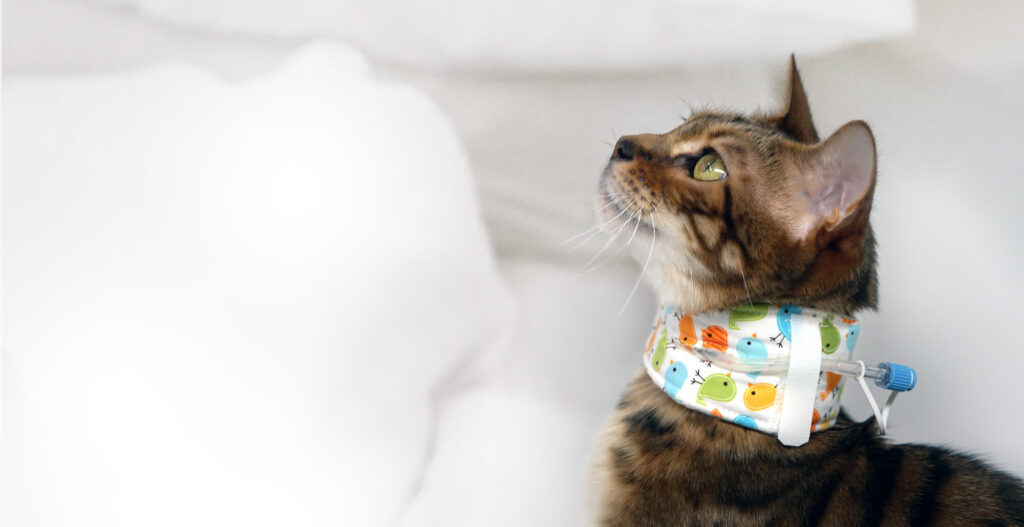
Medicating Dorie has always been a challenge because she can sniff out anything no matter how well I try to hide it, but during her illness it became impossible. Even worse, the fear, anxiety, and stress (FAS) she experienced during my attempts to medicate her were almost as traumatizing to me as a pet parent as they were to her. When she didn’t respond to hospitalization I brought her to a specialty hospital for endoscopic biopsies, and during her anesthetic procedure the internist placed an esophagostomy tube (E tube).
The sense of relief I felt at having the option to medicate her and feed her through the tube without causing FAS was immense. Dorie was ultimately diagnosed with inflammatory bowel disease and required weeks of immunosuppressive doses of steroids before she started body slamming her toys again, and without her E tube I wonder if she would have recovered.
As Fear Free practitioners we always try to consider a pet’s wants vs. needs, but when treatments are medically indicated for an unwilling sick pet, we have to find a different approach. The use of E tubes provides a compassionate solution to disease management that should be considered for a variety of illnesses and not only as a last resort.
Historically, many veterinarians have recommended E tubes for gastrointestinal diseases such as feline hepatic lipidosis, cholangiohepatitis, IBD, and pancreatitis. These pets can have a prolonged road to recovery and the conversation about E tube placement should be started with clients early–when their pet has had anorexia reported for a few days. At best, syringe feeding an icteric cat with hepatic lipidosis can fall short of the caloric needs required for their recovery. At worst, it can result in aspiration pneumonia, fear of the client, and injuries as the client struggles with the pet.
Conditions that cause oral pain, such as facial trauma and significant dental disease, are additional indications for E tubes when we consider the role of pain in contributing to FAS.
Rather than sending a pet home after full-mouth extractions with some canned food and oral pain medications and hoping for the best, we can have a proactive discussion with the client about an E tube at the time of surgery. This is particularly important in cases where the pet has already had decreased appetite preoperatively and adds minimal time and cost to the procedure. In cases of oral neoplasia where the client is not ready to pursue humane euthanasia, placement of an E tube to deliver nutrition and analgesia may provide at least some relief to the patient until the next quality of life discussion with the client.
In pets with chronic kidney disease, an E tube can make a huge impact on long-term management and maintaining the client-pet bond. I remember attempting to give subcutaneous fluids to my first cat with kidney disease and managing exactly one poke before she jumped off her cat perch and ran away while the fluid line whipped around, spraying fluids everywhere. Some clients are also uncomfortable with handling needles and having to inject their pet with fluids and can inadvertently poke themselves in the process. An E tube can allow a client to administer daily fluids and anti-nausea medications easily without causing FAS or discomfort.
In addition, many pets with CKD find renal diets unpalatable and develop nausea, inappetence, and weight loss as their azotemia worsens, leading their owners to feed them whatever they will eat. Placement of an E tube ensures that their pet will receive both adequate nutrition needed to maintain their body weight as well as the recommended prescription diet to try to slow progression of their disease.
While there may be an increased level of anesthetic risk for patients with CKD or other underlying health conditions, placement of an E tube1 is very quick (typically less than 30 minutes for placement and radiographic confirmation of location) and can provide weeks to months to even years of benefit. Once the stoma heals, it may be possible to exchange the tube through the same stoma site without general anesthesia by using topical anesthesia and the techniques outlined by Dr. Sheri Ross in 2016, in which she describes one feline patient with CKD whose stoma site was maintained for almost 5 years using E tube exchanges2 .
Perhaps one of the challenging aspects of E tubes is overcoming the perceived stigma attached to the tube itself. Some clients may agree to several days of hospitalization for their pet but draw the line at an E tube because they associate it with end-of-life care. While this may be true with some conditions such as oral neoplasia, in others an E tube can actually save their pet’s life or improve management of a chronic disease. Most pets with an E tube also don’t seem to notice it at all, and will eat, drink, groom, and even body slam their toys with their E tube in place.
Some clients may also feel squeamish at the prospect of handling and using an E tube for their pets. Washable, patterned neck wraps such as the Kitty Kollar3 or Kanine Kollar have been amazing at minimizing the “medical” aspect of E tubes, and their website provides a great starting point for educating owners when initiating an E tube conversation. Once the E tube is placed and the pet is ready to be released from the hospital, provide written discharge instructions4 with a recommended schedule for medicating, watering, feeding, and cleaning based on that pet’s calculated water and caloric requirements to ensure that the pet is getting everything they need. Scheduling a teleconsult the following day and printing a weight chart for the patient at every recheck will provide additional guidance and positive reinforcement. When your client realizes how easy it is to treat their pet with the E tube, you can consider asking them to be a resource for others who are on the fence about having one placed for their pet.
E tubes can be used successfully for a variety of acute and chronic illnesses, and their ability to remove the FAS associated with treatments is significant. Weighing the risks vs. benefits of the brief anesthesia needed for placement is important, but when routine medical management is inadequate, we need to be proactive in advocating for our patients and work together to destigmatize these invaluable tools.
Resources
This article was reviewed/edited by board-certified veterinary behaviorist Dr. Kenneth Martin and/or veterinary technician specialist in behavior Debbie Martin, LVT.

True enrichment goes way beyond simply providing dogs with food puzzles each day. For instance, a comprehensive enrichment strategy incorporates all types of enrichment: social, occupational, physical, nutritional, and sensory. This course will show you how to engage all the senses, as well as how to thoughtfully determine which enrichment activities are most appropriate for individual dogs, how to enrich the lives of dogs in a veterinary clinic, and those who are recovering from an injury and on restricted exercise.
This course, approved for 1 RACE-approved CE hour, was written by Laura Ryder, CPDT-KA, KPA CTP, IMDT.
This course consists of four lessons:
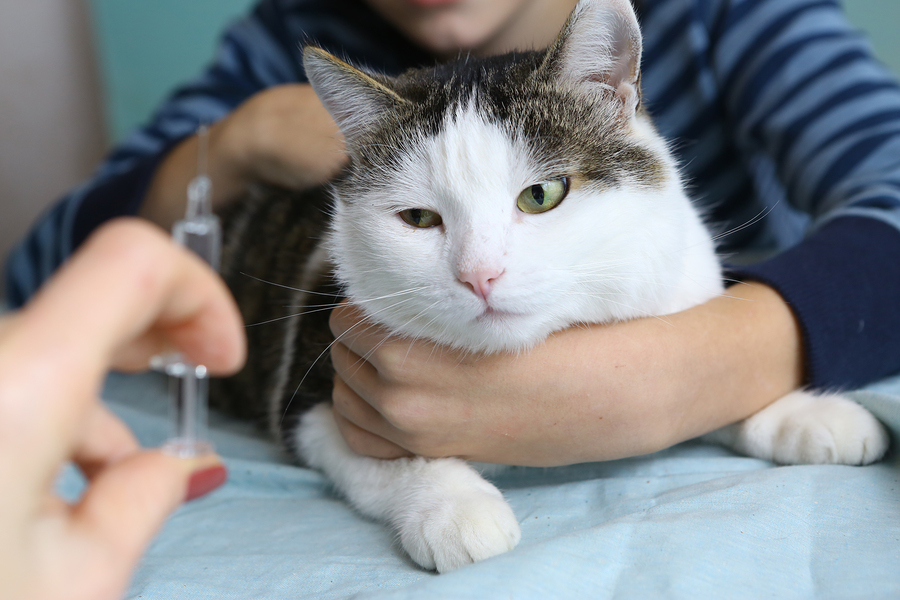
I have encountered a similar level of panic in a number of my clients faced with the diagnosis of diabetes in their cat. Beyond the stress associated with costs of initial diagnosis and treatment, many clients have a high level of anxiety at the thought of giving their cat injections and may even consider euthanasia for a disease that is often ultimately manageable. We can provide a huge service to our patients by educating both clients and our fellow veterinary professionals on Fear Free methods of handling diabetic cats.
Fear of needles is nothing new in the veterinary clinic. We see it develop all the time in pets when they jump with the poke of a vaccination. Over time, they begin to anticipate that when their skin is touched, pinched, or lifted, a needle will follow. You may even observe this occurring within the course of the same appointment when you have to give several vaccines. While we set a goal for diabetic remission in our feline patients, unfortunately this won’t be possible or permanent for all cats, so getting clients comfortable with handling their cat for injections is vital.
The good news about managing diabetic cats is twofold: insulin needles are tiny and most diabetic cats love food. I normally ask owners to administer insulin while their cat is obliviously munching away on breakfast or dinner. For those with a cat like Puff, taking time to desensitize and countercondition the baby steps leading up to the injection is recommended since these types of cats always seem to know when their owners are up to something.
Start with having the owner find a comfortable location in the house for feeding and insulin administration and practice remaining next to their cat while the cat is eating. Next, have the owner desensitize the cat to being petted between the dorsal shoulders while eating, followed by desensitization and counterconditioning to the owner gently lifting and releasing the skin. For needle-reactive cats, practicing fake injections with the tip of a pen. Using the Fear Free vaccination technique of applying numbing cream a few minutes before injection will help ensure that the process remains more positive and less like a horror movie where the owner is chasing the cat around the house with an uncapped needle.
Have you ever taken a blood glucose reading from a cat in the clinic while he’s growling and hissing and wondered how accurate your 391 value was? Similar to Doppler blood pressure, if your feline patient has an FAS level of 4 or 5, you may not be able to trust those blood glucose numbers.
To minimize stress hyperglycemia, all of the normal Fear Free recommendations you would make for reducing FAS associated with vet visits apply to in-clinic blood glucose curves: desensitization and counterconditioning to the carrier, low-stress handling at the clinic, and most of all, pre-visit pharmaceuticals. Unfortunately, even with taking all of these precautions, your feline patients will likely experience some stress. If you rely on serum fructosamine you’ll get a general idea of their level of blood glucose control over the preceding week but miss the nadir and other parameters. As a result, home blood glucose monitoring has become a much more common and Fear Free method of assessing diabetic control.
Historically, I’ve asked owners to purchase their own AlphaTRAK™ glucometer kit online and scheduled a technician appointment for a demo with their cat on how to obtain the needed microdrop of blood from the marginal vein along the haired portion of the ear pinna. Similar to desensitization and counterconditioning to handling the cat for insulin injections, the same approach can be used for blood glucose sampling. Using a cotton ball to stabilize the non-haired portion of the pinna and a 27-gauge needle will improve patient comfort.
Clinics can create a standardized home blood glucose curve form containing patient information, current diet, current insulin type/dose, blood glucose level prior to the start of feeding/insulin, and readings every 2 to 4 hours over a 12-hour period. Once this is completed and emailed back to the clinic, a blood glucose curve consult fee can be charged to the owner prior to having the doctor contact the client. While you may get some pushback from clients regarding this fee, keep in mind that the fee is typically a fraction of the cost charged for an in-clinic curve, and client education on home blood glucose sampling will empower owners to verify hypoglycemia if symptoms are seen and seek veterinary care if indicated.
Recently, continuous glucose monitors (CGM) such as the Abbott Freestyle Libre™ glucose monitor have provided another option for Fear Free management of diabetes. While these products are used off label in pets and require an in-clinic visit to apply the device, they can provide continuous interstitial (subcutaneous) glucose sampling for 10 to 14 days on feline patients where an at-home curve is not possible.
Once the small sensor is applied to the skin, the owner simply scans the device with their phone periodically to transmit the data, which can also be shared with the clinic. A glucose curve consult fee can be charged to the owner at the time of application of the CGM that will cover the consult with the veterinarian at the end of the two-week period. CGM can also be used to reduce FAS at the clinic for hospitalized diabetic cats such as those receiving treatment for diabetic ketoacidosis or pancreatitis.
Caution must be used to avoid overinterpretation of glucose readings by the owner, and even when placed correctly the sensors may fail to obtain data. However, the ability to avoid multiple needle pokes at home or in the clinic makes these devices an appealing Fear Free alternative to how we traditionally monitor diabetic patients.
In the age of Covid and curbside veterinary care, many clinics have ventured into teleconsults, which are a great addition to the Fear Free toolkit. What could be more Fear Free than helping your patient from the comfort of their own home?
Once a veterinarian-client-patient relationship is established based on the rules of your state, clinics can offer paid video teleconsults with an experienced technician or a veterinarian to guide a client through low-stress handling for insulin injections and blood glucose sampling while they are working with their own cat. Teleconsults also allow for education on signs of FAS that the owner may not pick up on such as a flicking tail tip or flattening ears that necessitate a change in handling.
Feline diabetes can be a challenging disease for owners as well as veterinary staff, and as always, we need to consider the client’s lifestyle and the patient’s symptoms in our recommendations. Whether your patient is at home or at the clinic, tailoring your treatment plan to include Fear Free techniques will help build confidence and increase success with disease management.
This article was reviewed/edited by board-certified veterinary behaviorist Dr. Kenneth Martin and/or veterinary technician specialist in behavior Debbie Martin, LVT.